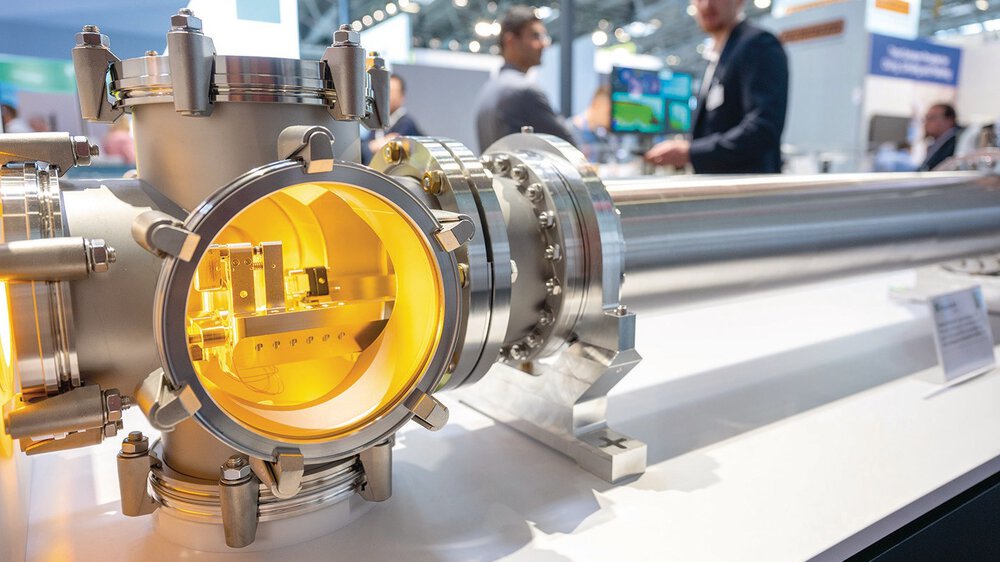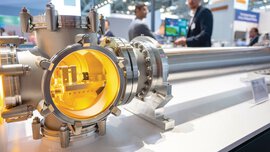Lasers pave the way to compact secondary radiation sources
February 5, 2025
- Focus on secondary sources in the laser industry
- Applications in medicine, the semiconductor industry, and quality assurance
- Leading suppliers at Laser World of Photonics 2025
When short pulse lasers hit certain materials, they emit electron, neutron, proton or X-ray beams that can be used in a variety of ways. This phenomenon is the key to ultra-compact radiation sources in which photons accelerate the particles. There is major market potential, which the laser industry is only just beginning to leverage. The leading players will meet at Laser World of Photonics in Munich from June 24 to 27, 2025.
Secondary sources are regarded as a future market for photonics. Short laser pulses excite matter to emit radiation that can be used for industrial, medical or scientific purposes. Extremely ultraviolet (EUV) radiation generated in this way is now used to incorporate nanostructures into the latest generation of microchips. Laser-based neutron beams will soon make it possible to analyze materials through the walls of bins and containers in order to detect drugs or weapons in ports or to analyze the content of sealed nuclear or toxic waste drums without having to open them. Laser-based electron beam sources promise deeper, spatially and temporally high-resolution insights into ongoing processes, and, in combination with artificial intelligence, could enable error-free laser welding and 3D printing processes or make the distribution of electrolyte visible when filling batteries. Or precisely focused electron and proton beams from compact secondary radiation sources could enable more targeted radiation to destroy cancer cells.
Ultrashort laser pulses as particle accelerators
In view of the variety of application areas and target markets, secondary sources are raising high expectations in the laser industry and will be a much-discussed topic at Laser World of Photonics. According to TRUMPF, the laser’s best days still lie ahead of us, especially with regard to secondary radiation. After all, they have the potential to revolutionize medicine and industry. Prof. Constantin Häfner, Director of the Fraunhofer Institute for Laser Technology ILT in Aachen, has a similar view. “The laser has not been fully researched. On the contrary: 60 years after its invention, things are just getting started.” He sees huge untapped markets for photonics with hundreds of billions of euros in sales potential—and, alongside quantum technology, cyberphotonics, sustainability and fusion names secondary sources.
The optimism is also based on the fact that the photonic core component of the secondary radiation sources is maturing rapidly: high-power ultrashort pulse and short pulse lasers with average power in the kilowatt (kW) range. Current projects, also in the Fraunhofer Cluster of Excellence Advanced Photon Sources (CAPS), are aiming to increase the output to 10 kW while maintaining high beam quality and pulse durations in the pico- and femtosecond range. Such lasers are the prerequisite for radiation sources with high particle energy and particles accelerated almost to the speed of light. The momentum is provided by the photon packets emitted by the lasers. They literally sweep the electrons, protons or neutrons along with them, sometimes only a distance of a few millimeters. Where huge particle accelerators hundreds of meters long were previously necessary, compact, mobile beam sources are now feasible.
High-tech in its purest form
EUV (extreme ultraviolet) lithography has already matured into an industrial process that generates billions in sales. LASER exhibitors Fraunhofer IOF, TRUMPF and ZEISS laid the foundation for that. In high-tech systems, 50,000 drops of tin per second are fired into a high vacuum where they are hit twice with pulses from a high-performance CO2 laser from TRUMPF. This ignites tin plasma, which emits EUV radiation with a wavelength of 13.5 nanometers.
It will be even more complex to develop another future market for secondary sources: fusion power plants, in which the aim is for high-energy lasers to ignite a plasma of the hydrogen isotopes tritium and deuterium. To achieve that, the pulses in several hundred beam lines of next (but one) generation diode lasers would have to be charged with energy in order to ignite around 15 pinhead-sized fuel pellets per second. The demand for diode lasers for just one such power plant exceeds the current annual global production.
LASER players at the forefront
Nobel Prize winner Prof. Ferenc Krausz, who will be speaking at the World of Photonics Congress, is laying a further high-tech foundation for bringing secondary sources to maturity with his research into attosecond imaging. That’s because it allows processes that were previously not visible to be observed in detail, whether it’s the movement of electrons during chemical reactions, biochemical processes in living cells, or even quantum transitions. The focus is on attosecond EUV pulses, against which even processes in the femtosecond, picosecond or nanosecond range seem like slow motion.
In addition to major brands such as ams-OSRAM, Coherent, Jenoptik, TRUMPF and ZEISS, many of the Fraunhofer-Gesellschaft institutes, the Ferdinand-Braun-Institut—Leibniz-Institut für Höchstfrequenztechnik and numerous other LASER exhibitors from Germany and abroad are at the forefront of developing secondary sources. Among them are AFS—Active Fiber Systems from Jena, Class 5 Photonics from Hamburg, the French Exosens Group, the Canadian KLA Corporation, and the Japanese-German USHIO Inc.
Application Panel Secondary Sources at LASER 2025
The “Lasers and Optics” forum in Hall A2 of the Laser World of Photonics (June 24 to 27, 2025) will focus on the future field of secondary sources on an application panel. Leading experts from industry and science will provide insights into the current status quo of development and focus on promising target markets and applications for laser-driven secondary radiation sources.
Downloads
285107
Belonging images



- PR Manager
